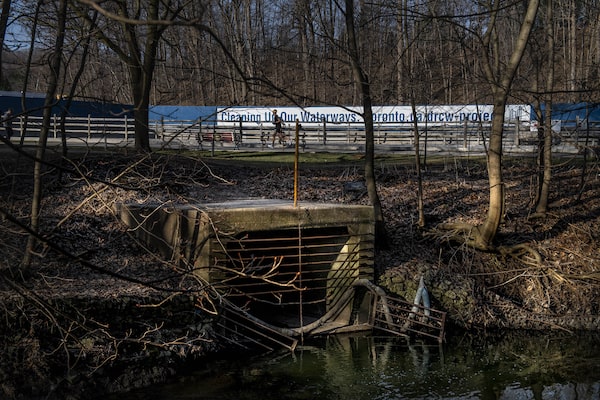
A storm drain running into Taylor-Massey Creek in Toronto on April 5, 2021.Aaron Vincent Elkaim/The Globe and Mail
Rachel Plotkin is boreal project manager at the David Suzuki Foundation.
There’s a kingfisher that I see almost every day when I walk my dog at Taylor Creek Park, in the heart of Toronto. (In fact, there might be two; I can’t tell on days with sightings at both the big pond and the little pond if it’s the same one, flying along the creek as I walk, or another.)
I marvel at it; not just its jaunty beauty, but at its ability to survive at all. After all, Taylor Creek has been awarded the title of the most polluted creek in Ontario. It’s estimated to be responsible for about 80 per cent of the pollutants entering the Don River.
Checkered among the clovers and grasses along the creek-side trails are numerous sewage grates. When it rains, sewage overflows into the creek, comingling with the existing phosphorus and nitrogen pollution, chloride, metals and road runoff.
Taylor Creek isn’t alone; the provincial Auditor-General’s State of the Environment report released in May notes: “Two key indicators of overall water quality for rivers and streams rate 60 per cent of monitored streams in Ontario as ‘fairly poor’ to ‘very poor’ based on biological health, and 41 per cent of monitored streams as ‘marginal’ to ‘poor’ based on water chemistry.”
I often stand at the bank of the creek and look for signs of life. But aside from stocked salmon in the fall, I rarely see any fish. (There are frogs in the ponds, though, cheering every spring morning.)
I gaze at the kingfisher, brashly guarding its polluted territory, and wonder: How does it remain so vital and undefeated? Sometimes I feel that I am commiserating with it (while recognizing that it’s unlikely to lament over the corrupted state of its environs itself).
I love Taylor Creek, but it feels significantly compromised to me. The creek also plays host to foxes, deer, owls, muskrats and herons, but I worry that these creatures must often face duress, so boxed in are they by the pressing city, pollution and busy roads. The same could be said of my experiences at the Leslie Street Spit, at the mouth of the Don.
Happily, there is good news on the horizon: Work is under way to redo the sewage system along Taylor Creek as part of a program to restore the Don. The city says that “once fully implemented, the program will virtually eliminate the release of combined sewer overflows into the Lower Don River, Taylor-Massey Creek and Toronto’s Inner Harbour.”
So much hope lies in our ability to restore. The conservation community has thrown its support behind Canada’s commitment to halt and reverse the loss of nature by 2030, and is working to ensure that this commitment is bolstered by a clear action plan..
Yet restoration, while a solid solution to the environmental degradation that mars so many landscapes and waterways, also begets a slew of questions. When can we assume a mess is sufficiently cleaned up? What baselines are we working toward when we aim to maintain and restore ecological health? How do we set static targets for a world that is dynamic and changing?
After the restoration efforts in Taylor Creek are completed, the water quality will hopefully be much improved, but the creatures that live there will continue to be significantly influenced by our heavy human touch.
Good on the kingfisher that the current, sorry state of affairs isn’t reflected in its proud chest feathers. I e-mailed the Toronto and Region Conservation Authority one day, wondering about how these birds could sustain themselves at the creek, and it replied that the creek typically harbours six fish species: blacknose dace, creek chub, fathead minnow, longnose dace, northern redbelly dace, and white sucker.
This knowledge is a salve on days when the creek is an alarming, opaque colour, or filled with unsightly foam. The kingfisher’s ability to eke out its existence brings me hope; there are minnowy signs of nature carrying on at the creek that I can’t read, just as it can’t read the physical signs outlining the timeline for the water-improvement project.